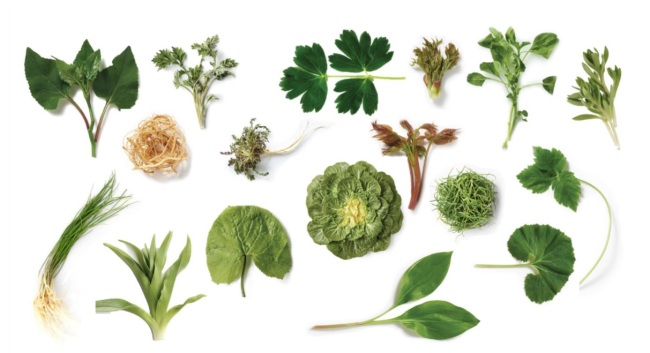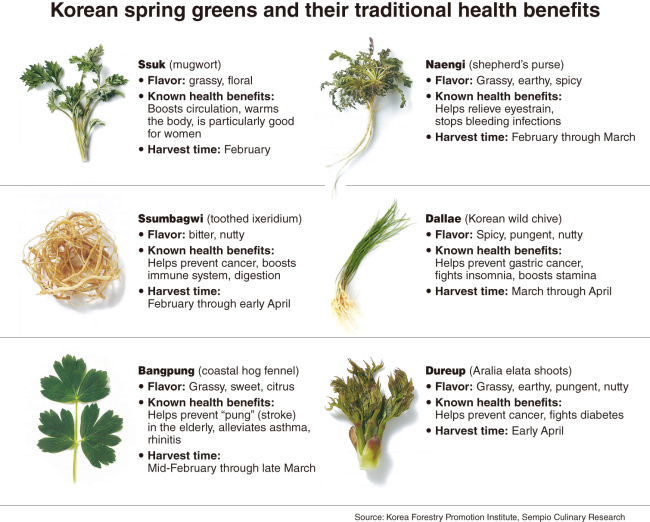In South Korea, now is the time to enjoy fresh spring greens, or bom namul.
Found everywhere from mountain slopes to roadsides, these wild plants come in many varieties and each has its own unique charm.
Although some namul are now cultivated and therefore available year-round, the arrival of freshly foraged leaves -- plentiful and cheap for just over a month -- at local markets is a welcome harbinger of spring.
 |
(Yonhap) |
“For me, it’s naengi (shepherd’s purse) that tells me winter is almost over,” said Kang Sun-ae, a 69-year-old housewife.
“Having deongjang jjigae with naengi on the table is like a ritual at this time of the year to celebrate the arrival of a new season,” she added, referring to Korean soybean paste stew made with the seasonal herb.
When she was younger, Kang used to venture out into the fields and climb mountains to forage for the season’s bounty. Now less active and living in an urban area, she mostly buys naengi and other spring greens at nearby markets.
Many South Koreans still forage for their greens -- some illegally or without due regard for their safety, according to the Korea Forest Service.
When spring approaches, the agency tasked with maintaining and protecting the nation’s forests issues warnings about illegal or dangerous foraging and sends its officers to patrol key sites.
“Foraging at private forests without the consent of landowners is illegal. It is a crime punishable by up to five years in jail or a fine of up to 50 million won ($43,940),” said agency representative Kwon Jang-hyun.
On the eastern island of Ulleungdo, four people have died since last spring while foraging for the island’s famous wild leaves, myeongi namul. Some died in falls and others got lost in the forest.
Back in the kitchen, Koreans traditionally believe that eating bom namul helps them recover the energy they lost in winter and rejuvenate their bodies for the coming summer. Some spring greens, such as mindeulle (dandelion), ssuk (mugwort) and dallae (Korean wild chive), have proven anti-cancer properties.
Young people these days think namul requires advanced cooking skills and excessive preparation time -- which, according to veteran cook Lee So-young, is not quite true.
“Namul is tastier when cooked quick and simple,” said Lee, who runs a Korean side dish store at Hyundai Department Store. “It is almost like medicine for our body, with many health properties.”
To make namul dishes easier to prepare, Sempio Culinary Research suggests a simple and versatile sauce made with only three ingredients -- soy sauce, sesame salt and sesame oil -- in a 2:2:1 ratio.
“If the soy sauce is good, the combination of these three is sufficient to make a delicious namul dish,” the company’s researchers wrote in a report published earlier this month, based on a two-year study of Korean spring greens.
It can be served with most vegetables regardless of whether they are blanched, boiled, panfried or served raw.
According to the researchers, sugar and pepper are unnecessary, and the addition of minced garlic and scallion -- the usual practice for most home cooks -- can make namul side dishes spoil faster.
At the same time, Sempio also challenges home cooks to get creative with namul, suggesting new culinary creations, such as a creamy spread for bread made from aged dallae or a variation on Mexican salsa that uses chamnamul -- another spring plant indigenous to Korea -- in place of cilantro.
 |
(Korea Forestry Promotion Institute, Sempio Culinary Research) |
Here is a recipe for a quick and easy namul dish made from dureup (Aralia elata shoots), a plant highly prized as the “king of the spring herbs” for its unique flavor and health benefits.
Dureup with cho-gochujang
Servings: 4
Ingredients
• 450 grams dureup
• 1 tablespoon salt
Sweet and sour gochujang sauce (cho-gochujang)
• 2 tablespoons gochujang (Korean red chili pepper paste)
• 2 tablespoons vinegar, or more if you like
• 1 tablespoon sugar, or more if you like
• 1/2 teaspoon minced garlic
• 1 teaspoon sesame oil
• 1/2 teaspoon sesame seeds
Blanch the duruep and serve with this delicious traditional sauce.
Recipe courtesy of Ro Hyosun of Korean Bapsang at koreanbapsang.com.
By Lee Sun-young









